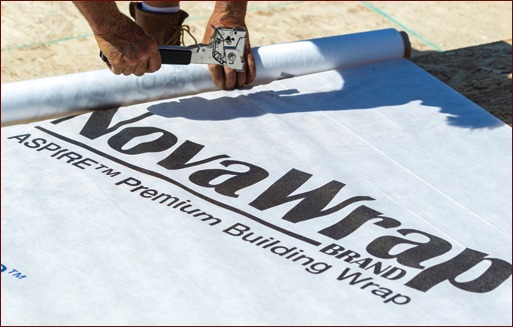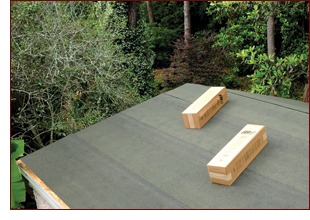Waterproofing
Using Housewrap for Masonry Applications:
What You Should Know
According to the U.S. Department of Energy, weather-resistive barriers (WRB) such as housewrap – also known as building wrap – are recognized as an indispensable part of exterior wall systems, protecting building materials from exterior water penetration and keeping them dry. When used properly, the material improves a building’s durability, decreases maintenance costs, and reduces the risk of moisture-related problems such as mold and mildew. No matter what type of exterior cladding is used – and that includes stone and brick veneer and newer stucco systems – WRBs are essential to effective moisture management.
For some time now, building codes have required the use of WRBs like housewrap in the construction of frame buildings. That’s because any siding material, be it wood, masonry, vinyl or a combination of each, does not serve as a barrier to driving rain. Building science recognizes the need for such a barrier behind the siding to keep water from reaching the interior sheathing or framing.
This article will take a look at what constitutes a WRB, what types are available, what steps should be taken during installation, and how technological advances in housewrap in particular have made it the best choice in some construction projects. And, since masons regularly are tasked with installing housewrap during construction, it’s essential to be well versed in the product category and the proper installation techniques that will help them meet the latest building codes.
An overview
What is a WRB? The Air Barrier Association of America defines a WRB is a thin membrane intended to resist liquid water that has penetrated behind the exterior cladding. A properly installed WRB will improve the overall moisture efficiency of a building’s wall system. Water is channeled down the outside surface of the WRB, thus reducing the potential for condensation buildup in the wall assembly, which reduces the likelihood of rot and degradation.
There are two main types of WRB. One is building paper, which is a traditional paper sheet or felt material that is asphalt coated or impregnated to increase its strength and resistance to water penetration. It does not have breathability and can trap moisture in the wall cavity. The other type of WRB is housewrap – sometimes called building wrap – which is made of a synthetic material, usually polymeric-based sheets of plastic. It has become the predominant WRB used in the construction industry today.

Housewrap has a number of advantages over building paper. It is lighter weight and produced in wider sheets, so that the material can be more quickly applied to the home’s shell. The product has three main performance criteria: blocks liquid water from entering the wall assembly, allows water vapor to escape from the wall cavity, and seals the building to reduce air infiltration.
Many different varieties of housewrap are on the market. Understanding the differences can be quite challenging. Some are woven and others non-woven. Some have perforations, others are low-perm micro-porous, and still others are non-perforated. The International Code Council-Evaluation Service (ICC-ES) is the U.S. leader in evaluating building products for compliance with residential and commercial codes. It has developed a list of WRB criteria to consider, which include:
- Resistance to Water Penetration
- Durability
- Vapor Permeability
- Air Resistance
Products for changing building codes
|
||
Recent changes in some state building codes, which comply with the International Energy Conservation Code addressing energy efficiency as it relates to a structure’s thermal envelope, are requiring that only housewrap manufactured as a continuous air barrier be used in most construction projects. An air barrier, in this instance, would be a sealed housewrap assembly that forms a continuous barrier to outside air infiltration coming into the interior sheathing. In the vanguard of this code change is the state of Georgia in the United States, which has instituted a new state energy code that mandates that WRBs, including housewrap, must qualify as an air barrier.
Manufacturers of housewrap products such as IPG (Intertape Polymer Group) NovaWrap ASPIRE Premium Building Wrap are educating customers in Georgia and elsewhere about how the ASPIRE product meets and exceeds the requirements of the tougher state energy code.
When NovaWrap ASPIRE was put on the market, it was created to address what IPG saw as the deficiencies in the housewrap technologies available, at that time, to builders and building owners. The product is 100 percent non-woven, polypropylene fabric that is designed to resist water penetration from the outside, while allowing the structure to “breathe,” thereby preventing moisture damage. Unlike other housewrap products that are manufactured with micro-perforations, NovaWrap ASPIRE is completely non-perforated to deliver better protection against water and air intrusion, better energy efficiency due to less air loss, and a balanced degree of water vapor transmission to avoid hot humid exterior air condensing on cooled interior walls.
The IPG Product Development team incorporated other features into the product to address drawbacks in competitive products on the market. Unlike some of the market-leading housewraps, NovaWrap ASPIRE stretches easily and conforms easily to building details. The translucent fabric allows for easy location of studs and overlaps, and the superior tear and puncture resistance saves on fasteners and creates less repairs and waste. It also can be left exposed to the elements for up to six months.
Masonry installation
Special consideration needs to be paid when applying housewrap to buildings with brick or stone veneers. These types of veneers serve as “reservoir” cladding systems, which can absorb water during rain events and then warm up when the sun comes out. This causes vapor to drive into the wall cavity if the housewrap has a high moisture vapor transmission rate. That is one reason why it’s best to steer away from micro-porous weather barriers and, instead, choose one with a non-woven substrate and non-perforated coating of advanced breathable polymers. This type of wrap exhibits superior performance water resistance with the ability to allow vapor to escape from wall cavities. WRBs are not required over actual concrete or masonry walls, only over stud or frame wall construction (per 6.1.5.1 of the 2008 Masonry Standards Joint Committee.)
NovaWrap, like most of the better housewrap products on the market, can be installed under bricks, stone, stucco, EIFS, rigid foam, as well as wood and fiber cement siding. When working with stone veneers built over wood frame construction, the 2009 International Building Code (Section 1405.6) requires two layers of housewrap or other WRB. IPG recommends attaching one layer of its product to the sheathing and using an additional layer to the exterior side. In other words, the WRB should be separated from the stone and mortar by a second layer of WRB. The first layer, which was applied directly over sheathing or studs, serves as the wall system’s WRB and should be integrated with window and door flashings.
Brick facades require a ventilated air space – a minimum of one inch – between the housewrap and the cladding. It’s essential to follow the manufacturer’s guidelines regarding the use of an air space between the brick veneer and the sheathing.
As building science continues to evolve, product development specialists are working to create the right WRB products to better help reduce air infiltration, cut utility costs, improve indoor air quality, and increase comfort. The ultimate goal is to help system specifiers, designers, architects and contractors meet sustainability goals for the betterment of the environment.
| Miami-Dade Approves MFM’s Isolation Barrier Underlayments |
 MFM Building Products, a manufacturer of a full envelope of waterproofing and weather barrier products for the building industry, says its line of IB Underlayments have been approved by Miami-Dade to comply with the Florida Building Code, including the High Velocity Hurricane Zone. A copy of the Notice of Acceptance (NOA) No. 11-1205.03 can be found at www.miamidade.gov. MFM Building Products, a manufacturer of a full envelope of waterproofing and weather barrier products for the building industry, says its line of IB Underlayments have been approved by Miami-Dade to comply with the Florida Building Code, including the High Velocity Hurricane Zone. A copy of the Notice of Acceptance (NOA) No. 11-1205.03 can be found at www.miamidade.gov.
The MFM IB line of underlayment products are self-adhering with a mineral surface membrane. The specialized, rubberized asphalt adhesive system aggressively bonds to the substrate and self-seals around nails and other fasteners. These products may be applied over the entire roof deck with proper ventilation, under roofing at edges, valleys, vents, skylights and chimneys to protect from leaks caused by ice dams, melting snow and wind-driven rain. The Miami-Dade NOA includes the following MFM IB products: IB-3 IceBuster (36 inches X 33, 67 and 75 feet), IB-3 StormStopper (36 inches X 67 feet), IB-4 StormStopper (36 inches X 67 feet), IB-3 ShingleStarter (36 inches X 33.5 and 67 feet) and ShingleStarter (7.2 inches X 33.5 feet). All 36-inch-wide underlayments come with a split release liner for ease of application. For more information, visit www.mfmbp.com. |
